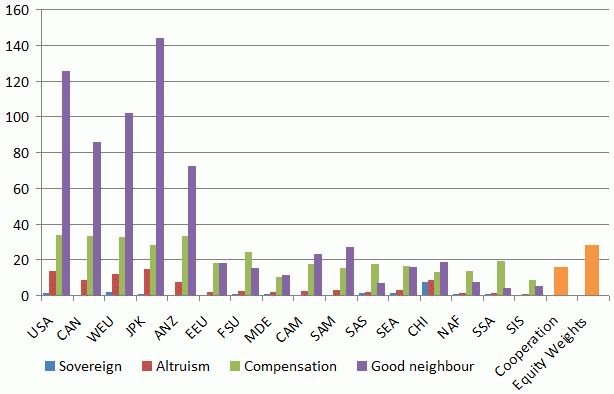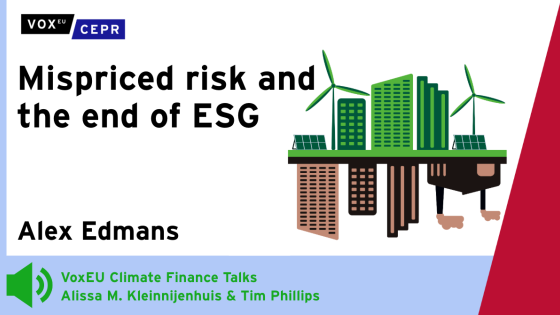Climate change is a moral problem. The main reason to reduce greenhouse gas emissions is a concern for faraway lands (Schelling 2000), distant futures (Nordhaus 1982), and remote probabilities (Weitzman 2009). The people who emit most are least affected by climate change, and the benefits of their abatement would be dissipated. Carbon dioxide lingers in the atmosphere for decades and the effects on temperature and sea level play out over even longer periods. Central projections have that climate change and its impacts are a nuisance for rich countries and a problem for poor countries. But there is a chance that things will go horribly wrong. If you do not care about risk, the future, or other people, then you have little reason to care about climate change.
In a recent paper (Anthoff and Tol 2010), we propose a novel way to evaluate the impact of climate change on other people. In the early days of cost-benefit analyses of climate policy, researchers estimated the impacts of climate change on different countries, monetised them based on local values, and added up the dollar terms to arrive at an estimate of the world total damage (Pearce et al. 1996). In turn, this was used to estimate the social cost of carbon – the level at which greenhouse gas emissions should be taxed.
This method is simple but wrong. It disregards that a dollar is worth more to a poor woman than to a rich one. Another objection is that a risk to life in a poor country is valued differently than a risk to life in a rich country. Therefore, analysts proposed to use equity weights (Fankhauser et al. 1997). Essentially, impacts are valued locally but national estimates are weighted when aggregating to the global total, with the weights correcting for income differences.
However, this method is inappropriate for national decisions. Equity weights presume a global welfare function. In other words, a global, benevolent planner would use equity weights. That does not mean, however, that a national government should do the same. Particularly, equity weights are less than one for rich countries. If the government of a rich country uses equity weights to estimate the carbon price, then it discounts the impacts on its own electorate while emphasising the impacts in other jurisdictions (Anthoff et al. 2009).
We propose four alternative ways in which a national government might value impacts in other regions of the world when computing a social cost of carbon that could be used in domestic cost-benefit analysis. Each method considers the domestic impacts as valued in the home country, but the methods use different principles to consider impacts abroad:
- Sovereignty: Ignore impacts abroad.
- Altruism: Empathise with people abroad.
- Good neighbour: Feel guilty if damage is done to people abroad.
- Liability: Compensate if damage is done to people abroad.
The first principle stands out. The differences between the other three principles are more subtle. An altruist cares about others in general, while a good neighbour cares about what she does to others. An altruist may be tempted to try and solve all the worlds problems through climate policy (although with the right separability conditions this point is moot at the margin). A good neighbour would consider the impacts as they are perceived by the victims and therefore use the victims’ discount rates. If you are liable for future damage, you use your own discount rate.
We use FUND, an integrated assessment model, to estimate the social cost of carbon, the additional damage done if one extra tonne of carbon dioxide is emitted today. Figure 1 shows the results, assuming a pure rate of time preference of 1% per year and an inequality aversion of 1. The sum of the regional social costs (“cooperation”) is $16/tC (in 1995 dollars), well within the range of estimates in previous studies (Tol 2009). Split over 16 regions (“sovereignty”) the social costs are obviously much lower. China stands out as very vulnerable. This is due to a range of factors, including its large size, ageing population, precarious water supply, and economic concentration in the coastal zone. For regions with slow (fast) growth, the compensated social costs are higher (lower) than the cooperative costs. The equity-weighted social costs are $28/tC, almost double the simple sum as more weight is placed on the higher impacts in the poorer regions. Good-neighbour social costs are much higher than equity-weighted damages for rich regions, and lower for poor regions. Altruistic social costs are somewhere in between the sovereign costs and the good-neighbour costs.
Figure 1. The regional marginal damage costs of carbon dioxide (in $/tC).
USA=US of America; CAN=Canada; WEU=Western Europe; JPK=Japan and South Korea; ANZ=Australia and New Zealand; EEU=Eastern Europe; FSU=Former Soviet Union; MDE=Middle East;CAM=Central America; SAM=South America; SAS=South Asia; SEA=Southeast Asia; CHI=China; NAF=North Africa; SSA=Sub-Saharan Africa; SIS=Small Island States; Source: (Anthoff and Tol 2010).
Policy implications
The policy implications are twofold.
- First, a wide range of carbon taxes can be defended.
The highest carbon tax differs from the lowest carbon tax by up to a factor 70. This large difference is solely due to different ethical positions on the kind of responsibility one country should have towards other countries. That is a political decision.
- Second, without cooperation, different regions will have different carbon taxes.
However, a lack of international cooperation on target-setting does not necessarily lead to low carbon taxes. If countries agree to compensate one another for the damage they do to one another, carbon taxes would be substantial. That obligation already exists in principle, but practice is different. A treaty on international liability would most likely reduce emissions further than an international treaty on emission reduction.
References
Anthoff, D, CJ Hepburn, and RSJ Tol (2009), "Equity weighting and the marginal damage costs of climate change", Ecological Economics, 68, (3):836-849.
Anthoff, D and RSJ Tol (2010), "On international equity weights and national decision making on climate change", Journal of Environmental Economics and Management, 60(1):14-20.
Fankhauser, S, RSJ Tol, and DW Pearce (1997), "The Aggregation of Climate Change Damages: A Welfare Theoretic Approach", Environmental and Resource Economics, 10(3):249-266.
Nordhaus, WD (1982), "How Fast Should We Graze the Global Commons?", American Economic Review, 72(2):242-246.
Pearce, DW, WR Cline, AN Achanta, S Fankhauser, RK Pachauri, RSJ Tol, and P Vellinga (1996), "The Social Costs of Climate Change: Greenhouse Damage and the Benefits of Control", in JP Bruce, H Lee, and EF Haites (eds.), Climate Change 1995: Economic and Social Dimensions -- Contribution of Working Group III to the Second Assessment Report of the Intergovernmental Panel on Climate Change, Cambridge University Press, 179-224.
Schelling, TC (2000), 'Intergenerational and International Discounting', Risk Analysis, 20(6):833-837.
Tol, RSJ (2009), "The Economic Effects of Climate Change", Journal of Economic Perspectives, 23(2):29-51.
Weitzman, ML (2009), "On Modelling and Interpreting the Economics of Catastrophic Climate Change", Review of Economics and Statistics, 91(1):1-19.




